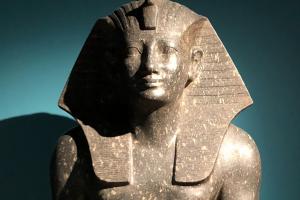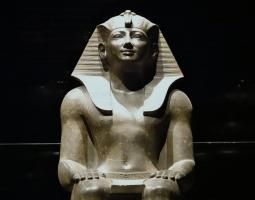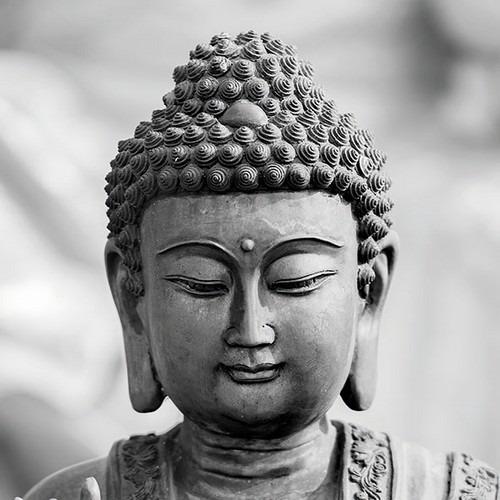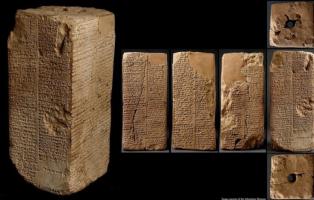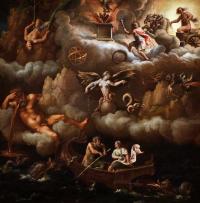The immortal beauty of Thutmose IV
By Marianne Luban ©
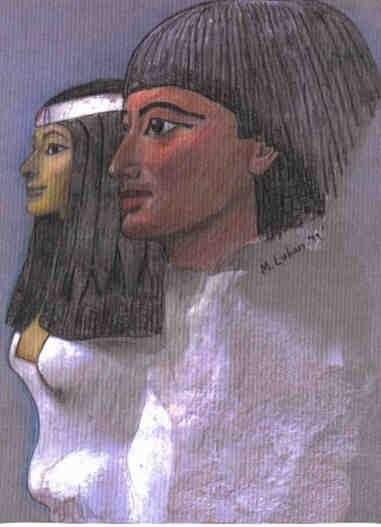
It is Year 8, the 3rd month of Akhet, day 1, of the reign of King Horemheb. Maya, the agent of the pharaoh and his assistant, Thutmose, enter the tomb of King Menkheperure Thutmose IV and view the aftermath of sacrilege. Menkheperure's tomb has been broken into by thieves and Maya and his men are given the task of setting it right. When they complete this piety with great care, they inscribe a record of it on a wall in the tomb, communicating to unknown future persons that they had done their best to insure that King Thutmose's earthly dignity be restored and that his soul could be at peace.
What did Maya and Thutmose witness? Were they able to report to their lord, Horemheb, that Menkheperure still had most of his grave goods and that his coffins were still in good condition? Or did the restorers merely try to repair the broken shabtis and other funerary equipment that was left? Did they simply lay the mummy, stripped of its amulets and gold, its mask and coffins burnt for the precious metals they might yield, into its red sarcophagus? We may never know, because KV43 was entered, again, both by robbers and those on official business, the tomb being discovered in 1903 in a state of chaos by Howard Carter. However, Carter recorded that the sepulchral hall, where stood the sarcophagus, showed signs of being carefully resealed on two occasions, the first no doubt being the work of the great official, Maya, and his crew. Therefore, even though Carter found everything that remained in the tomb vandalized and broken-up by the 20th Century, AD, matters may have been quite different in the 21st Dynasty when the royal mummies were relieved of their valuables and moved to "a handful of easily guarded caches" (Reeves) , one of them being KV35, the tomb of Amenhotep II, where the body of his son, Thutmose IV, was eventually found. It is interesting to note that the heart scarab of this king was discovered in an unauthorized excavation on Sardinia, it somehow having found its way there in ancient times.
Although the king, presently on exhibit in Cairo, is now an emaciated, blackened shell--"light as a blown egg", as John Romer would say--his is a mummy that inspires admiration. Dead though he may be these last 3,000 years, there is no extant portrait of this pharaoh that comes as close to being the advertisement for Thutmose's former glory that his own well-preserved face is. There is simply nothing gruesome about it. The features appear gentle and peaceful to a remarkable degree. Magnificent teeth gleam between well-shaped lips in a sort of smile that seems to express satisfaction with eternity. The mummy gives the impression of saying "Yes, this is death. We all must die, but I cheated death because my beauty refused to die with me. Look upon me now and know what manner of princes sat on the throne of Egypt".
Of course, the calm aspect of Menkheperure's mortal remains belie an ancient tragedy. King Thutmose IV died young, albeit just how young is a matter for dispute. Wente and Van Siclen (1976) maintained that he was a maximum of thirteen years of age when he acceded to the place of his father and was perhaps even younger, despite the propaganda of the "Dream Stela", which has him hunting in the desert near the Great Sphinx before he became king. The highest attested regnal year of this Thutmose is Year 8 and the tradition according to Manetho ascribes to him between nine and ten years of rule. Nevertheless, based on evidence of jubilee and other indications of a longer reign, Wente and Van Siclen have proposed a reign of up to thirty-three years for Menkheperure and Klaus Baer (1976) has submitted a possible Year 20. Therefore, some would suggest the king could have been as old as nearly fifty when he died, although this seems not to be corroborated by anatomical signs. Wente et al, in the "X-ray Atlas of the Pharaohs", give him an age-at-death range of 30 to 40 based upon radiological examination.
In the early years of his accession, Thutmose IV is shown with his mother, Queen Tio, by his side, which has been seen by some as an indication of a minor coming to the throne. Regardless of disagreement concerning age, there can be little doubt that the pharaoh was the offspring of a beautiful woman, whom he closely resembled. Tio bore neither the title of "King's daughter" nor "King's sister" and it appears that, for the first eight years of the rule of her husband, Amenhotep II, Tio was not his Chief Wife or possibly not even married to him. A stela of Year 9 indicates Tio's name has been substituted for that of an earlier queen. However, this does not suggest that Tio has been elevated because of any new status of her son as Crown Prince because at this time it is certain that a Prince Amenhotep still held this distinction. Yet the fact that the name of Prince Amenhotep was erased on steles in the vicinity of the Great Sphinx, coupled with the spurious intervention of the latter in the story of Thutmose's accession, denotes dynastic strife in the latter part of the reign of Amenhotep II.
In fact, regarding Tio--there is some doubt whether she was ever "Great King's Wife" at all and this title may have been given to her only after her son became pharaoh, just as was the case with Thutmose III and his mother. So Thutmose IV could have been born of a lowly but lovely concubine whose features he inherited, thereby escaping the receding chins, jutting noses and pronounced overbites so prevalent among the royals in the beginning of the 18th Dynasty. Even though there is a superficial family resemblance between their mummies, just how much the face of Thutmose differed from that of his sire, Amenhotep, is clearly illustrated in the pair statue of the noble, Sennefer, and his wife, Hatshepsut, now in the Louvre. How charming this couple is--and how somehow very modern! In the New Kingdom, it was very usual for the nobility to be portrayed with the face of the current sovereign, men and women alike. That is why so many husbands and wives in Egyptian art seem to have the same face. But not Sennefer and Hatshepsut.
Arthur Weigall saw the lower parts of five statues in a certain cenotaph at Gebel Silsileh, which he describes in his "A Guide To the Antiquities of Egypt":
"(West Bank) A roofless tomb is now reached, in which the lower parts of five statues can be seen. These and the scenes on the walls show that a certain Sennefer was buried here with his wife, Hatshepsut, these names dating them to the 18th Dynasty. Sennefer was a libation priest of Amen attached to the palace at Thebes, and seems to have been the son of the "Royal Son, Governor of the lands of the South", Usersatet and of Anun his wife. The Lady Hatshepsut was the daughter of the chief nurse of the king, named Hemttaui, and her husband Seninefer, a priest. Other relations were a High Priest of Horuar and Sebek of Ombo, a High Priest of Nekheb (at El Kab), a Priest of Khnum, and others whose names and titles are now lost. On the north wall Sennefer and his wife are seen seated before a table of offerings, while before them a male harper plays upon a large harp and two nude women, one playing a stringed instrument, dance for the amusement of these dead persons, etc., etc...."
Sennefer, then , was a very grand person, indeed, the son of a King's Son of Kush, as they were called, or perhaps he was even the progeny of an actual royal prince. The countenance of Sennefer first struck me by its beauty and by the fact that it looks enough like the face of the mummy of King Thutmose IV to be his twin! Whether the priest was an actual relative of Menkheperure cannot be known for certain but the cenotaph definitely indicates that it was begun in the time of Amenhotep II. In fact, the Lady Hatshepsut has features that match those of that pharaoh's mummy. So, what may have happened is that the sculptor began the group with the figure of the wife during one reign and finished Sennefer's image in the next. Such is the twist of fate that give Hatshepsut the more rugged face of Amenhotep and her husband the beauty of Thutmose IV. In my view, this much-damaged work of art is a powerful argument that the king was already a grown man upon the death of his father (at least in oriental terms) and was, indeed, thirteen years old at minimum. Since we have numerous tomb paintings from the time of Thutmose IV, we can easily recognize the full lips that sit so closely beneath the blunt , slightly aquiline nose of Sennefer--as we have seen these features drawn many times before, almost in caricature. Yet Sennefer's portrait shows us, for the first time, how attractive they were in actuality. The features certainly do not suggest those of a lad of thirteen.
King Menkheperure was described by Grafton Elliot Smith in his "The Royal Mummies" (1912) as "a young, extremely emaciated man with a long, oval, effeminate face". However, my artistic reconstruction of this face demonstrates that this "effeminate" look of the mummy is probably due to the fact that the delicate bone-structure is all too evident in death and the fatty tissue and muscle that would have lent a more robust appearance are now dissipated. Yet it cannot be argued that the pharaoh, now measuring 1.646 metres (probably no taller than 5' 6'' in life) was a slightly-built gentleman by our standards. "Pretty-boy" or no, Thutmose IV doubtless had as many wives and concubines as any other Egyptian monarch and a considerable number of attested children. In Year 7, we see the name of a lady that could be read as either "Iaret" or "Wadjet", who is styled "King's daughter, King's sister and Great King's Wife". This could be taken as a sign, perhaps, that Thutmose was not old enough to be married until he had been king for seven years and then he was given his own sister or half-sister for a bride. It is best, probably, not to read too much into this tardy attestation as it is just as possible that the princess was not mature enough to marry her brother until his seventh year of rule. Or there is yet another explanation. Images in the tomb of a royal tutor indicate that the future Amenhotep III was the eldest son of his father and the "heir apparent". That could mean that Amenhotep may have been born when Thutmose IV was still a prince, it being unknown when the king began to cohabit with Amenhotep's mother. Therefore, the successor could have been already in his teens when he came to the throne. Did Thutmose, then, marry his own eldest daughter, "Iaret", toward the end of his reign in order to prevent his growing sons (as well as a co-regent) or any other claimants from doing so? If "Iaret" was the "heiress", under this theory of the rules of the succession, then King Menkheperure did the same as the rulers who followed him, including Amenhotep III, himself. Then it would follow that in Year 2 of his reign, Amenhotep was still a co-regent with Thutmose, and had to marry a commoner, Tiye--just as Akhenaten was prevented from marrying a royal princess while co-regent with *his* sire.
Other principal queens of Thutmose IV are Nefertary and possibly Nebetnehet. In the process of forging an alliance with Artatama I of Mitanni, the Egyptian king requested the hand in marriage of Artatama's daughter. After the sixth appeal, permission was granted and an unnamed girl now made her way to Egypt. Some scholars once believed that this was Mutemwiya, but exactly who Mutemwiya was cannot be known because nothing definite is attested of her while her husband lived. Mutemwiya was, of course, the mother of the successor, Amenhotep III, and may have been styled "Great King's Wife" only after the accession of her son.
How many sons were born to Thutmose IV besides the boy who was eventually to succeed him cannot be precisely determined, although the Theban tomb of Heqarneheh seems to indicate that the pharaoh had at least seven male children. Funerary equipment, including four limestone canopic jars of a "King's son, Amenemhet", all with stoppers portraying the king, were found in KV43, the tomb of Menkheperure. Also discovered in the tomb was the mummy of a small prince, wearing the traditional side-lock. This may be Amenemhet, the sole occupant of the burial chamber, as his august father had long since been moved to KV35, the tomb of Amenhotep II. The odds and ends of two additional burials remained in KV43, as well--that of a Princess Tentamun and an unknown individual. Nicholas Reeves suggests that all three were off-spring of Thutmose IV, who had predeceased their father, the Prince Amenemhet perhaps being the re-wrapped and re-coffined mummy discovered by the Metropolitan Museum Expedition buried close to the Deir el Bahri cache. If this is true, then we have the mummies of three of the pharaoh's sons.
Besides Princess Tentamun, a mortuary chapel of an official named Sobekhotep confirms the existence of another daughter of Thutmose IV called "Thiaa", she being the grandchild of this Sobekhotep. A tomb on Abd el-Qurna hill, strewn with rifled mummies, yielded fourteen wooden labels inscribed in hieratic with the names of putative daughters and grand-daughters of King Menkheperure. They are Nbtia, daughter of the king's son, Sa-Atum (raising the possibility of another named son of the pharaoh), Tiaa (who is probably the same as Sobekhotep's grand-daughter), Tataw (perhaps to be read as "Tawi"?), Py-Ikhia, Pypuy (or "The Little Daughter of 'Iawy"), Henut-'Iunuw, Ptah-Meryt, Sat-Hri, Neferu-Amen, Wiay (perhaps short for "Mutemwiya", after the king's wife), Amen-em-Ipt, and Nsw-Khat.
Whether any of these royal daughters were ever married to anyone except possibly their own father is difficult to say and it is not unlikely all may have spent their lives languishing in the House of the Royal Children, a place unattested other than in this tomb, or in that well-known institution, the Royal Harem. We can safely conclude that none of the princesses ever left Egypt because we do not doubt Amenhotep III when he told a foreign petitioner "From olden times, no king's daughter has been given in marriage outside of Egypt".
Even though not much is known about the family life of Thutmose IV, even less is known about his public life. King Menkheperure's reign, like that of his son, was dedicated to diplomacy and was largely a peaceful one, so one cannot associate him with military campaigns and conquest. There was really no need for Thutmose IV to engage in such enterprise, as his father and grandfather had handed down to him an empire. We note a Nubian campaign for the king in Year 8, successful as all such ventures were reported to be. He engaged in some building, notably his own mortuary temple, and erected an obelisk or two. It is during the reign of this Thutmose that we first encounter mention of the solar god, Aten. That a King of Egypt had plenty to occupy his time at home is understood and that Menkheperure Thutmose IV of the noble mien was able to appear a true prince before his own subjects and the envoys who came from afar to bring him tribute can scarcely be doubted. Kings and queens have been portrayed in splendid garments throughout the ages, yet, somehow, I don't think anyone has ever looked as majestic or as elegant as the Pharaoh of The Two Lands in his pleated, bleached kilt or whatever embroidered or sequined tunics he normally wore, his streamlined crowns, the cobra rearing on his brow, his body covered with gold and bright stones, blazing like the sun, his belt and apron heavily encrusted with gleaming threads, beadwork and studs--even his sandals being works of art. Nevertheless, one cannot help but wonder if the mystery behind the words on the "Dream Stela" was ever forgotten during the reign of King Thutmose IV or whether some terrible act or injustice hinted at there haunted him throughout his brief life. A proclaimed Crown Prince, after all, need not accomplish a task in order to win his father's throne. That is only how things are done in fairy tales:
"Behold me, look at me, thou, my son Tehutimes. I am they father, Horemakhu, Kheper, Ra, Temu. The kingdom shall be given to thee and thou shalt wear the white crown and the red crown on the throne of the earth-god Seb, the youngest among the gods. The world shall be thine in its length and breadth, as far as the light of the eye of the lord ofthe universe shines. Plenty and riches shall be thine; the best from the interior of the land and rich tributes from other nations. Long years shall be granted thee as thy term of life. My countenance is gracious towards thee and my heart clings to thee; I will give thee the best of things. The sand of the district in which I have my existence has covered me up. Promise me that thou wilt do what I wish in my heart; then shall I know whether thou art my son, my helper..."
Bibliography
- Smith, G. Elliot, "The Royal Mummies" (1912)
- Wente, Edward F. & Harris, James E., "An X-ray Atlas of the Royal Mummies" (1980) Chicago
- Romer, John, "Ancient Lives" (1984) New York
- Clayton, Peter A., "Chronicle of the Pharaohs" (1994) London
- Reeves, Nicholas & Wilkinson, Richard H., "The Complete Valley of the Kings" (1996) London
- Weigall, Arthur, "A Guide To the Antiquities of Egypt" (1910) London
- Dodson, Aidan & Janssen, Jac. J., "A Theban Tomb & Its Tenants", JEA 75, 1989











